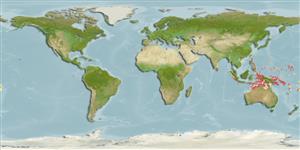>
Eupercaria/misc (Various families in series Eupercaria) >
Labridae (Wrasses)
Etymology: Paracheilinus: Greek, para = the side of + Greek, chaite = hair + Greek, odous = teeth (Ref. 45335).
More on author: Randall.
Environment: milieu / climate zone / depth range / distribution range
Ecologia
marino associati a barriera corallina; distribuzione batimetrica 18 - 31 m (Ref. 9710). Tropical
Western Central Pacific: Kwajalein Atoll, Marshall Islands. Replaced by Paracheilinus filamentosus from the Philippines (Ref. 37816).
Size / Peso / Age
Maturity: Lm ? range ? - ? cm
Max length : 6.5 cm TL maschio/sesso non determinato; (Ref. 9710)
Short description
Chiavi di identificazione | Morfologia | Morfometria
Spine dorsali (totale) : 9; Raggi dorsali molli (totale) : 11; Spine anali: 3; Raggi anali molli: 9. Females and juveniles lack the elongate dorsal and caudal fin lobes and electric colors of the males (Ref. 37816). Tubed peduncular scales 5-6; no distinct stripes on body (Ref. 41634).
Found among dense algal beds of deep lagoons.
Life cycle and mating behavior
Maturities | Riproduzione | Spawnings | Egg(s) | Fecundities | Larve
Oviparous, distinct pairing during breeding (Ref. 205).
Lieske, E. and R. Myers, 1994. Collins Pocket Guide. Coral reef fishes. Indo-Pacific & Caribbean including the Red Sea. Haper Collins Publishers, 400 p. (Ref. 9710)
IUCN Red List Status (Ref. 130435)
Threat to humans
Harmless
Human uses
Strumenti
Special reports
Download XML
Fonti Internet
Estimates based on models
Preferred temperature (Ref.
123201): 27.5 - 28.9, mean 28.3 °C (based on 22 cells).
Phylogenetic diversity index (Ref.
82804): PD
50 = 0.5000 [Uniqueness, from 0.5 = low to 2.0 = high].
Bayesian length-weight: a=0.00955 (0.00456 - 0.02002), b=3.06 (2.89 - 3.23), in cm total length, based on LWR estimates for this (Sub)family-body shape (Ref.
93245).
Trophic level (Ref.
69278): 3.4 ±0.45 se; based on food items.
Resilienza (Ref.
120179): Alto, tempo minimo di raddoppiamento della popolazione meno di 15 mesi (Preliminary K or Fecundity.).
Fishing Vulnerability (Ref.
59153): Low vulnerability (10 of 100).
